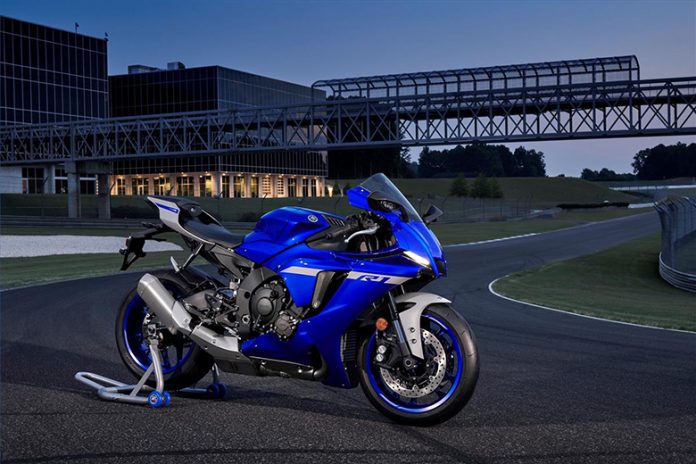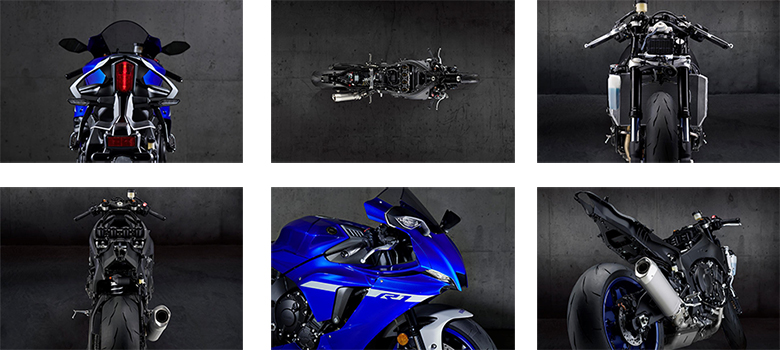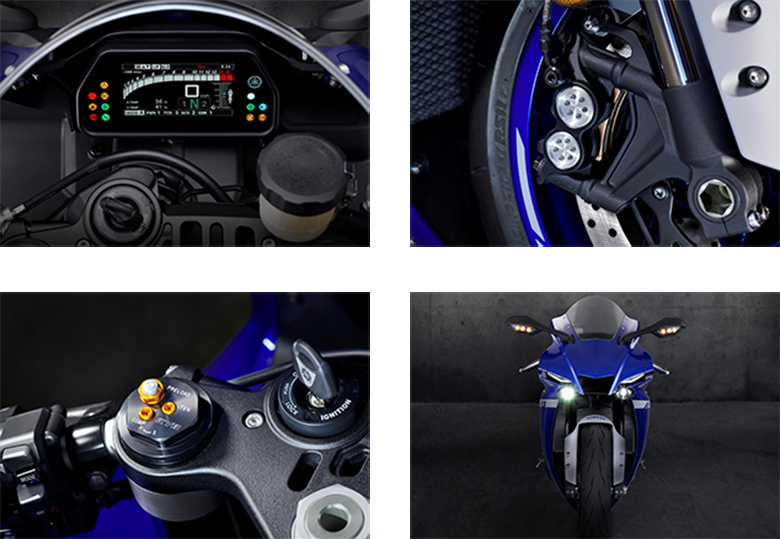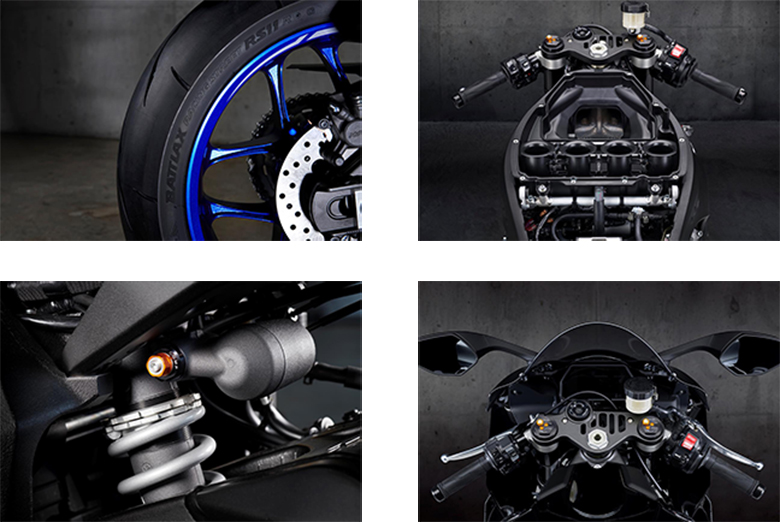The new YZF-R1 2021 Yamaha Sports Motorcycle is an excellent sports bike with plenty of impressive features. With next-generation R Series design, advanced electronic control, supersport braking and suspension performance, and a high-performance cross-plane engine, this car is ready to take on the competition.
YZF-R1 2021 Yamaha Sports Motorcycle – Features and Price
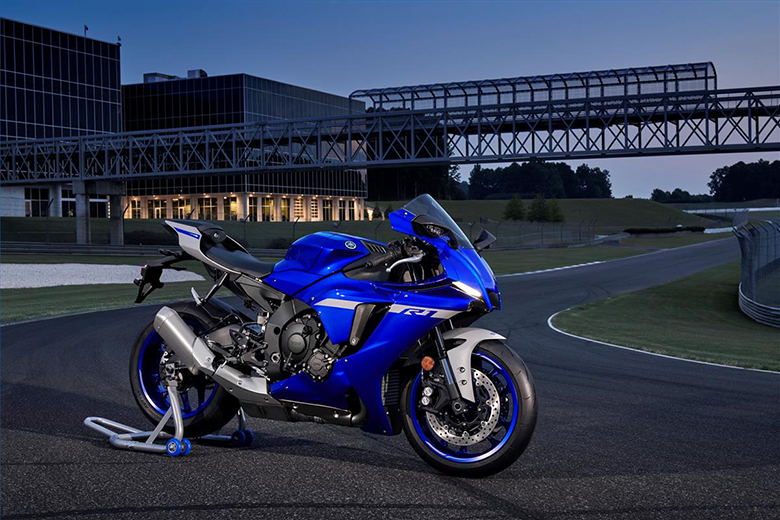
Top Features
Yamaha’s unique cross-plane crankshaft technology, developed from the YZR-M1 MotoGP® bike, is included in the 998cc inline four-cylinder engine. Every element of this one-of-a-kind engine is designed to excite. The R1® is equipped with a cable-free Yamaha Chip Controlled Throttle (YCC-T®) system that converts the rider’s inputs into motion, as well as a complete array of IMU-powered electronic rider aids that redefine the phrase “rider confidence.”
The braking system of the YZF-R1® is designed for track usage, with powerful 4-piston radial-mount front calipers, stainless steel front lines, oversized 320mm rotors with high-friction pads, and a compact ABS unit. The Bridgestone® RS11 tires provide genuine racing traction while maintaining a balanced road feel and handling.
The streamlined bodywork of the 2021 YZF-R1 creates an aerodynamic profile with an integrated and harmonious design. The YZF-R1 embodies almost 20 years of chassis technology established on racetracks across the globe, thanks to Yamaha’s sophisticated Deltabox® aluminum frame technology and high-spec, fully-adjustable suspension.
Yamaha engineers gathered data from racetracks all around the globe to raise the bar even higher. The engine, suspension, brakes, and aerodynamics round out the package, while the electrical features enhance rider confidence and control.
Engine
Yamaha’s unique cross-plane crankshaft technology, developed from the YZR-M1 MotoGP® machine, is included in the R1’s 998cc inline-four-cylinder engine. The CP4 motor directly senses linear torque by equalizing inertial forces at the crankshaft, providing the rider the most significant link between the throttle grip and the rear wheel.
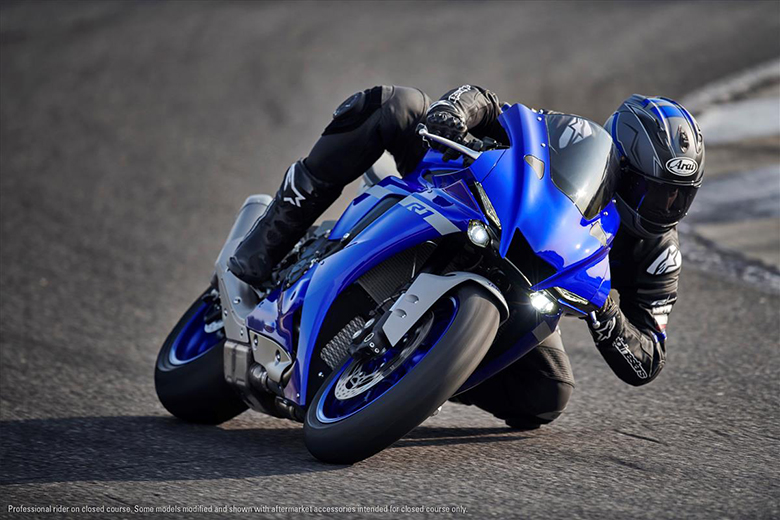
Yamaha’s precise fracture-split technique is used on titanium connecting rods to guarantee dependability while reducing weight. These lightweight components, when combined with titanium intake valves and forged pistons, enable the CP4 to reach its high redline and over-rev capabilities. Because the cylinder block is displaced from the crankshaft, friction loads on the pistons and bores are reduced.
To improve part-throttle performance, the cylinder head, intake system, fuel injectors, and airbox all work together. New injectors may spray fuel directly against the intake valves for better fuel atomization by producing a narrower and shorter intake tract.
Compact rocker-arm valve actuation utilizes improved geometry to allow more valve lift than traditional cam-driven systems while reducing friction losses with lower cam lobes and lower spring pressure. A muffler and heat shields made mainly of lightweight titanium are included on the R1. For optimum handling, the small midship muffler also centralizes mass low in the frame and as near the bike’s middle as feasible.
To best complement the high-revving engine, a 6-speed gearbox has close-ratio gearing. The input/output shafts are also “stacked” in the gearbox to concentrate mass and make the total engine size shorter front-to-back, which improves engine placement in the frame for excellent weight balance. When approaching bends aggressively, Yamaha’s assist and slipper clutch is utilized to offer the rider more confidence downshifts while still smoothly managing the torque of the R1’s high-output engine.
Chassis/Suspension
Yamaha’s Brake Control technology, which was developed on racetracks all over the globe, works in conjunction with an Antilock Braking System (ABS) to reduce brake slip while braking aggressively or on less-than-ideal conditions. An all-new adjustable BC system uses the IMU to offer progressive brake force intervention as the lean angle rises, giving the rider more confidence while braking in the middle of a turn.
For outstanding stopping power, the YZF-R1 has 4-piston radial-mounted front calipers riding on oversized 320mm rotors with a high-friction pad composition, all backed by a 220mm rear disc and small floating caliper. The ABS hydraulic unit is small and light, with high-quality braided stainless steel front lines that offer robust yet responsive control. For a great front-end feel on the track, the R1 has an inverted KYB® front fork, including 43mm inner tubes and a 4.7-inch stroke with complete adjustability. Under extreme circumstances, the shim-stack damping pistons enhance the road feel. To make tuning more accessible, all adjustments are made on the top of the fork legs.
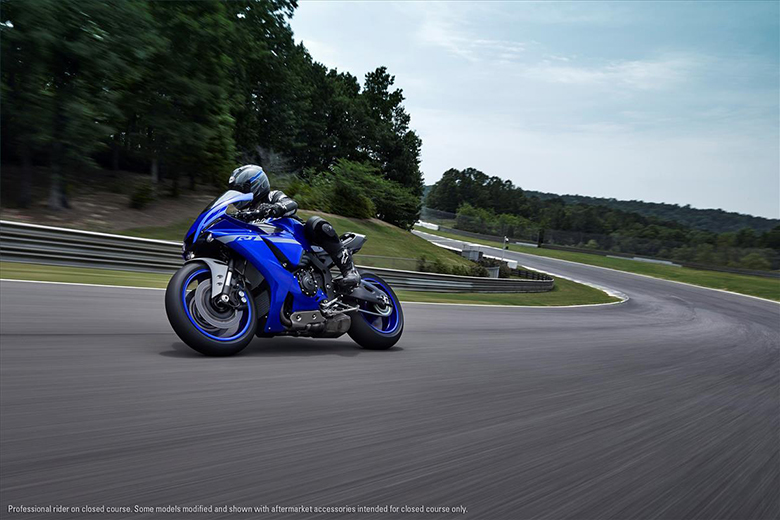
The rear bottom link pivot on the fully adjustable KYB® shock is perfectly positioned to offer outstanding handling and suitable transfer of engine torque to the track surface. Internal settings have been updated to match the front fork change.
The R1 is equipped with Bridgestone® RS11 tires, intended to provide real racing traction while maintaining a balanced road feel and handling. Compared to standard aluminum cast alloy rims, 10-spoke cast magnesium wheels have a reduced rotational mass, lowering unsprung weight for rapid direction changes and sensitive handling. The thin aluminum Deltabox® frame, magnesium subframe, and aluminum swingarm all work together to provide a small chassis with excellent track-focused performance. For optimum rigidity balance and outstanding cornering performance on the racing track, the motor mounts utilize the engine as a stressed frame component. The aluminum alloy fuel tank provides the rider a naturally lower body connection to the bike. It weighs 3.5 pounds less than a similar steel tank, significantly lowering total weight.
Additional Features
The YZF-R1 has bodywork that creates an aerodynamic profile, as well as attractive lines that give the bike a sleek and integrated look. LED headlights are small and light, allowing for a more streamlined front cowling design with excellent visibility. The lights provide a wide range of lighting. For better aerodynamics, LED front turn signals are incorporated into the mirrors, while the LED taillight is attractive and extremely visible. The R1 has a dazzling full-color thin-film transistor (TFT) meter with front brake pressure and fore/aft G-force readouts that provide rider input. It has a street mode and a track mode that concentrates on performance data like YRC settings (including EBM and BC systems), a zoomed-in view of the tachometer in the higher rpm range, a lap timer, gear position indication, and speed.
Electronics
The Yamaha Chip Controlled Throttle (YCC-T®) technology on the R1 is based on the Accelerator Position Sensor with Grip (APSG), which removes the need for throttle cables. YCC-T, as previously, detects the rider’s throttle input and actuates the throttle valves to actively regulate intake volume, enabling cutting-edge computerized engine management in a lighter package.
Yamaha’s Chip Controlled Intake (YCC-I®), a variable intake system that spreads power throughout the whole rpm range, is featured on the YZF-R1. The CP4 engine can produce a wide range of energy throughout the rpm range by dynamically changing the length of the entire system depending on engine speed. The Inertial Measurement Unit (IMU) from Yamaha combines a gyro sensor and a G-sensor accelerometer to detect all six axes of movement in three dimensions at a rate of 125 computations per second. This data is sent into the Engine Control Unit (ECU), which creates a comprehensive image of the motorcycle’s location and subsequently powers Yamaha Ride Control, the R1’s rider-assist technology package (YRC).
The EBM system on the YZF-R1 enables the rider to customize engine braking based on personal preferences and track circumstances. To provide for a smoother turn entrance, the EBM system offers three levels of engine braking force. PWR mode allows the user to modify throttle feel, responsiveness, and overall power to suit their tastes and riding circumstances better. The PWR system has four progressive power delivery levels.
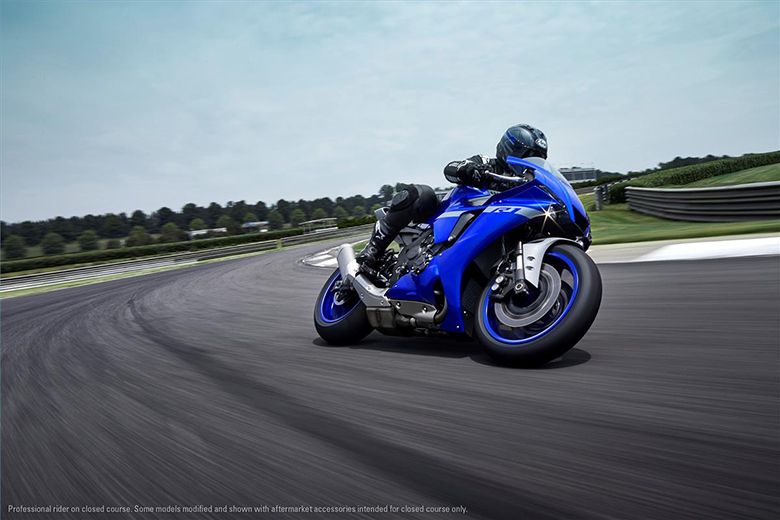
The R1’s TCS monitors and reduces undesired wheel spin during strong acceleration by calculating the variations in front and rear wheel speeds. The R1 utilizes the IMU to determine the lean angle, then changes the TCS intervention to best fit the rider’s needs, unlike many simpler TC systems. The TCS has ten different settings that allow the rider to fine-tune the degree of control required.
The SCS is derived from Yamaha’s YZR-M1 MotoGP® bike. The ECU intervenes to regulate the power supply and smoothly manage the motorcycle’s cornering attitude by utilizing the IMU to detect lateral slides under strong cornering acceleration. There are four settings on the SCS to accommodate rider preferences and track circumstances.
When the IMU detects that the motorcycle’s nose is pitching upwards higher or faster than intended, the Lift Control System gradually reduces engine power to maintain chassis attitude with minimum loss of forwarding motion. LIF has four adjustment options for precise tuning.
The R1’s LCS regulates maximum engine rpm and throttle plate opening with information from the TCS and LIF systems to optimize acceleration from a standing start, ensuring an optimal racing start every time. The LCS has three levels of engine control and output adjustment. The QSS modulates power while shifting using a sensor on the shift linkage, enabling split-second clutchless changes up and down through the gearbox. Full-throttle upshifts enhance forward drive under the influence, while downshifting requires the ECU to perfectly match engine speed for virtually instantaneous gear changes with minimal chassis disturbance. With separate downshift function control, the QSS may be changed between three settings.
YZF-R1 2021 Yamaha Sports Motorcycle – Price
The new YZF-R1 2021 Yamaha Sports Motorcycle is available at $17,399 in Team Yamaha Blue and Raven color option.
YZF-R1 2021 Yamaha Sports Motorcycle – Technical Specifications
Engine
| Engine Type | 998cc, liquid-cooled inline four-cylinder DOHC; 4-valves per cylinder |
| Bore x Stroke | 79mm x 50.9mm |
| Compression Ratio | 13.0:1 |
| Fuel Delivery | Fuel injection with YCC-T and YCC-I |
| Transmission | 6-speed; Wet multi-plate assist and slipper clutch |
| Final Drive | Chain |
Chassis
| Front Suspension | 43mm KYB® inverted fork, fully adjustable; 4.7 inches travel |
| Rear Suspension | KYB® single shock, fully adjustable; 4.7 inches travel |
| Front Brakes | Dual 320mm hydraulic disc; Brake Control System, and ABS |
| Rear Brakes | 220mm hydraulic disc; Brake Control System, and ABS |
| Front Tires | 120/70ZR17 |
| Rear Tires | 190/55ZR17 |
Dimensions
| L x W x H | 80.9 inches x 27.2 inches x 45.9 inches |
| Seat Height | 33.7 inches |
| Wheelbase | 55.3 inches |
| Rake (Caster Angle) | 24-degree |
| Trail | 4 inches |
| Maximum Ground Clearance | 5.1 inches |
| Fuel Capacity | 4.5 gal |
| Fuel Economy | 33 mpg |
| Wet Weight | 448 lb |
Other
| Warranty | 1 Year (Limited Factory Warranty) |
Conclusion
The new YZF-R1 2021 Yamaha Sports Motorcycle comes with plenty of unique features that most people love. The motorcycle has got a powerful engine with attractive chassis. In addition, the seat offers an aggressive riding position that has a full support of handlebars and carefully positioned footpegs.

